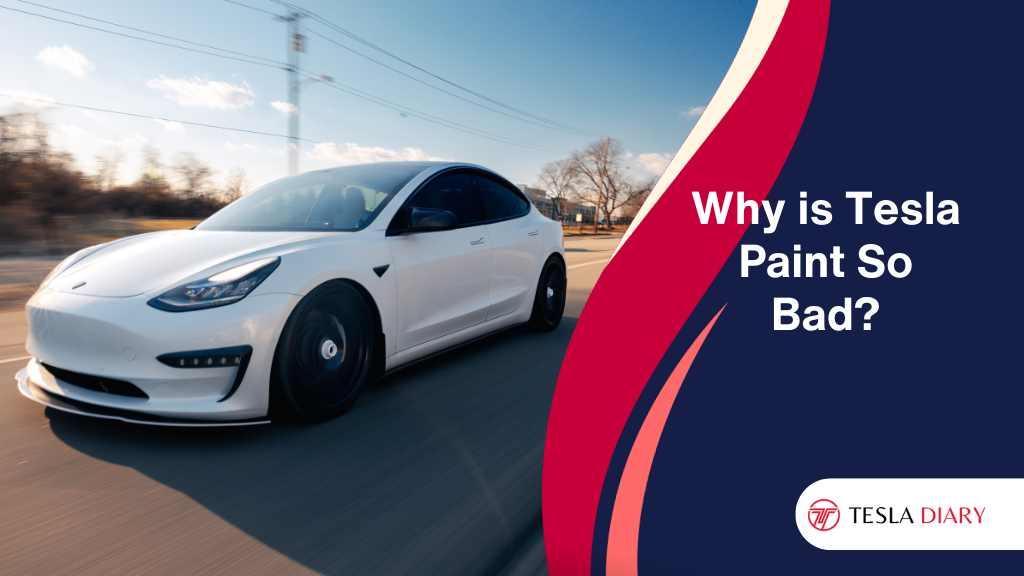When it comes to electric vehicles, Tesla has undeniably been at the forefront of innovation and popularity.
Their sleek designs, impressive range, and cutting-edge technology have garnered a dedicated following of Tesla enthusiasts.
However, one aspect of Tesla cars that has often been a topic of discussion and concern is the quality of their paint.
Many Tesla owners have reported issues with paint quality, which has led to the question: Why is Tesla paint so bad?
In this article, we will explore the reasons behind Tesla’s paint problems and discuss potential fixes.

Reasons for Tesla’s Paint Problems
Several factors contribute to the issues with Tesla’s paint quality:
1. Automated Painting Process
Tesla’s production facilities rely heavily on automation to meet the high demand for their vehicles.
While automation can increase efficiency, it may also lead to inconsistencies in the paint application process.
Automated robots can sometimes miss spots or apply uneven coats of paint, resulting in a less-than-perfect finish.
2. Speed of Production
To keep up with demand, Tesla has been known to prioritize speed in their production processes.
Faster production may mean less time for meticulous paint preparation and application, potentially leading to defects and imperfections in the final product.
The less time spent on a car, the more blemishes it will have at the end.
3. Water-Based Paint
Tesla uses water-based paint for environmental reasons, which is generally considered more eco-friendly than solvent-based alternatives.
However, water-based paint can be more prone to issues like chipping, fading, and clear coat peeling, especially if not applied and dried properly.
Tesla had some issues with their drying facility after the paint has been applied causing the paint to not be durable as expected.
4. Inadequate Quality Control
Some Tesla owners have reported that their vehicles were delivered with paint imperfections or defects that should have been caught during quality control inspections.
This suggests that there may be room for improvement in Tesla’s quality assurance processes.
Elon Musk’s Perspective on Tesla Paint Problems
According to Elon Musk, Tesla’s CEO, the issue is not that Tesla’s paint is inherently bad, but rather, it’s the painting process itself that’s at fault, especially in the Fremont factory..
Musk pointed out that the paint shop at Tesla’s Fremont factory has a long history, originally established 60 years ago as part of a collaboration between GM and Toyota. Today, it’s known as the NUMMI factory.
Tesla has made efforts to refurbish this paint shop to make it suitable for water-based painting processes and to reduce emissions to meet California standards.
However, Musk noted that the building itself isn’t large enough to facilitate the extended drying process that water-based paints require.
Musk further explained that in the rush to meet high production demands, the factory sometimes speeds up certain heating processes, resulting in paint defects that are not visible to the naked eye.
To maintain production speed, drying times are reduced, leaving some cars with certain paint defects.
This issue is primarily seen in Tesla Model 3 and Model Y vehicles, which have been in production since their early days.
Musk emphasized that this problem pertains only to cars painted in this particular shop and does not affect newer models such as the X or S.
Additionally, Tesla Model 3 and Y vehicles painted in other paint shops around the world do not exhibit the same problem, resulting in better paint quality in regions like Europe or China compared to the United States.
Will Tesla Fix Paint Issues?
While Elon Musk’s explanation sheds light on the root causes of Tesla’s paint problems, the question remains: Will Tesla take steps to fix these issues? Yes, it will.
The issue is already fixed in the newly produced cars as we have got reports of Tesla shutting down the Fremont factory which was behind almost all Tesla paint issues with Model 3 and Model Y.
However, if you happen to have a car that was made in that factory and experiencing issues with Tesla paint, we recommend reaching out to Tesla. You might be able to get the fix for free or reduced rate.
Does Tesla Warranty Cover Paint Defect?
Tesla’s warranty typically covers manufacturing defects and material issues, which could include certain paint defects. However, it’s essential for Tesla owners to understand the warranty terms.
You can only claim warranty for paint issues if they come out within 3 years of your purchase or 36000 miles. If any of these two criteria is met, you can’t get the paint issue fixed under warranty.
Also, Tesla can refuse to fix your paint issues even within the warranty period if your car is not well maintained or is driven under extreme conditions regularly.
To sum up, you can get the warranty benefit only if Tesla is to blame for the issue and you have done your part as a responsible owner.
Which Tesla Paint Color is the Most Durable?
The durability of Tesla paint colors can vary. Generally, darker colors tend to show fewer imperfections, while lighter colors may reveal defects more readily.
However, it’s essential to note that the paint quality issue discussed here pertains to the application process rather than the inherent durability of specific colors.
Frankly, there was no data or study available that proves any one color is more durable than the other. However, you do know that the color underneath the paint is silver.
So, silver or metal-like colors are most likely to keep your car’s aesthetics unharmed for longer than other colors like black, blue, or red.
In conclusion, Tesla’s paint quality issues have been a source of frustration for some customers.
While Elon Musk has provided insights into the root causes of these problems, it remains to be seen whether Tesla will take significant steps to address and resolve the paint quality issues.
As Tesla continues to evolve and expand, addressing paint quality concerns should remain a priority to ensure a positive ownership experience for their customers.

